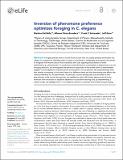Inversion of pheromone preference optimizes foraging in C. elegans
Author(s)
Dal Bello, Martina; Pérez-Escudero, Alfonso; Schroeder, Frank C; Gore, Jeff
DownloadPublished version (1.503Mb)
Publisher with Creative Commons License
Publisher with Creative Commons License
Creative Commons Attribution
Terms of use
Metadata
Show full item recordAbstract
<jats:p>Foraging animals have to locate food sources that are usually patchily distributed and subject to competition. Deciding when to leave a food patch is challenging and requires the animal to integrate information about food availability with cues signaling the presence of other individuals (e.g., pheromones). To study how social information transmitted via pheromones can aid foraging decisions, we investigated the behavioral responses of the model animal <jats:italic>Caenorhabditis elegans</jats:italic> to food depletion and pheromone accumulation in food patches. We experimentally show that animals consuming a food patch leave it at different times and that the leaving time affects the animal preference for its pheromones. In particular, worms leaving early are attracted to their pheromones, while worms leaving later are repelled by them. We further demonstrate that the inversion from attraction to repulsion depends on associative learning and, by implementing a simple model, we highlight that it is an adaptive solution to optimize food intake during foraging.</jats:p>
Date issued
2021Department
Massachusetts Institute of Technology. Department of PhysicsJournal
eLife
Publisher
eLife Sciences Publications, Ltd
Citation
Dal Bello, Martina, Pérez-Escudero, Alfonso, Schroeder, Frank C and Gore, Jeff. 2021. "Inversion of pheromone preference optimizes foraging in C. elegans." eLife, 10.
Version: Final published version